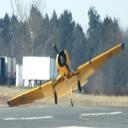Yahoo Answers is shutting down on May 4th, 2021 (Eastern Time) and beginning April 20th, 2021 (Eastern Time) the Yahoo Answers website will be in read-only mode. There will be no changes to other Yahoo properties or services, or your Yahoo account. You can find more information about the Yahoo Answers shutdown and how to download your data on this help page.
Trending News
Should ballistic recovery airframe parachutes be "phased in" for single engine aircraft that operate night or IFR over rugged terrain?
Although as pilots we are trained to do a forced landing in the event of engine failure and this IS the best option if you are visual for example with an empty field with adequate room for landing.
If over rough terrain,or a heavy built-up area in the case of landing or take off(at other times you should be able to glide clear of a built-up area by the regulations) in night and/or IFR wouldn't if be better to deploy an airframe chute (like on the Cirrus SR22 and some other models) and hope for the best?
6 Answers
- Anonymous7 years agoFavorite Answer
There is certainly something to be said for BRS type parachutes in the right circumstances.
The issue is that of training people when to use them, how to use them and when not to use them.
The first thing to realise is that as soon as you pull the handle you have committed your salvation to wherever the chute wants to take you, so, if you decide that the engine has failed over rough country and you need a hand, it will take you where it wants to go, which may not be the best choice. It is far better to retain control of your aircraft and your destiny until the last possible moment, then use it to go where you want to go.
If you use it low, going into wind, you can have much more control on which bit of the mountain you hit.
You also don't want to deploy it at 8500 ft over a nice flat field, only to drift into a nice flat lake!
Of course, if you are unrecoverably out of control, then yes, the sooner the better. Most Cirrus chute failures have been too low and/or too fast, after a loss of control.
If you are on fire, you need to leave it alone, the last thing you need is to spend any more time than you have to, in the vicinity of a fire. Get down quick and, if you need the chute, use it at the last possible moment, so that the canopy does not get involved with the fire.
So yes, good idea and undoubtedly we will see more aircraft with them, but the aim should still always be a controlled landing, at normal speed on a surface which is as much like a runway as it can be. The parachute is only useful when you can't do that.
EDIT: Yes, my personal view is to agree with Tracey. I don't think you can ever mandate these things. While there are definitely times when a whole aircraft chute has the potential to save lives, (and there used to be some fairly dramatic footage of an aircraft colliding with a glider tow cable on the net), the number of times these things have been deployed seems out of context with the types of problems some of these deployments were occassioned by. I am not sure that there is a sufficient problem that these chutes are needed to solve it.
I occassionaly fly a Flight Design CTLS, it has one fitted as standard. I can probably land that aircraft at less than 35 knots, with full harness a totally survivable speed, so deploying one after an engine failure is not really an option for me, except as a very last resort.
Other reasons to deploy it are few and far between. So most of the time it is 16 kg of payload I can't use.
It is not an excuse for poor airmanship if you are hoping it will save you from lapses in judgement you should not have made in the first place
Source(s): Retired Airline Captain - DickLv 77 years ago
I'm sure Eric West has heard of a situation where BSR saved some one. I've been in aviation a long time, and I don't know of one. Some have been deployed, and resulted in landing in trees, or rough terrain. No first hand knowledge of these incidents. Most aviation accidents occur on TO or landing, and at altitudes that would render a BRS useless. I think they may give amateur aviators a false sense of security. Like the ball player that flew his Cirrus into a building in NY a few years ago. Not sure I like the idea. They are on the Cirrus aircraft because of a design flaw that makes spin recovery difficult or impossible. Again I don't think it's a positive thing. It was a band aid fix for a major problem.
- Tracy LLv 77 years ago
The records for the SR22 should show you an interesting fact, lots of pilots have used the chute in comparison to the number flying! The real interesting part to me is those flying aircraft without them have not shown near the "needed" use of them! Are you SURE they are a necessity?
No doubt they have saved lives, but what in the same circumstances would have happened without the chute being available? Would pilots have landed? Would pilots have been more cautious? Would the pilot have needed the chute or was it used due to the chute being the EASY way out? There are more planes flying and have been for years without the chutes. Does the additional weight, expense, and service add value or encourage pilots to take chances they really should not take? I think more study is needed before mandatory requirements make them a required item!
During take off and landing...chutes are useless, they need time to deploy!
Source(s): Years without - TL - ?Lv 67 years ago
By “phased in” I assume you mean “mandated.” No. BRS is a great option for those that choose to have one, but the weather and terrain risks that you mention can be mitigated by flight planning, if the pilot chooses. Hostile terrain can be skirted and/or crossed with sufficient gliding altitude, along with pre-flight identification of viable emergency landing spots along the route. Weather is a choice. Not everyone who has an IFR-capable aircraft chooses to fly in minimum conditions. No need to force more expensive equipment on everyone. If you want to make general aviation safer, you need to address the most common causes of fatal accidents. Figure out how to prevent low-altitude stall/spin events.
- How do you think about the answers? You can sign in to vote the answer.
- 7 years ago
no. because they create inherent risk in NORMAL operations. also, they add one more line to your preflight procedures that you may skip. they also add another handle that you or your pax can pull, turning a pilot into another passenger of uncontrolled parachute.





